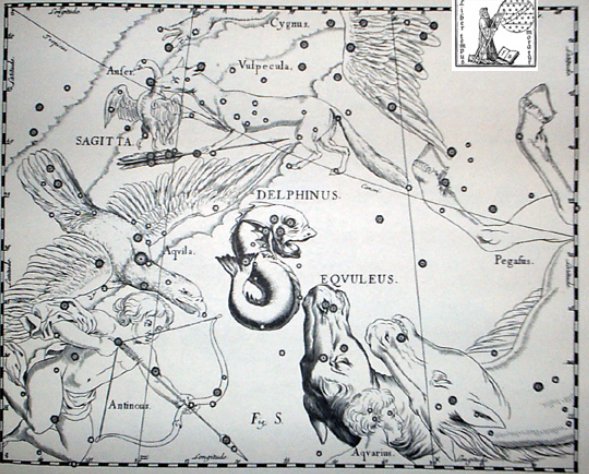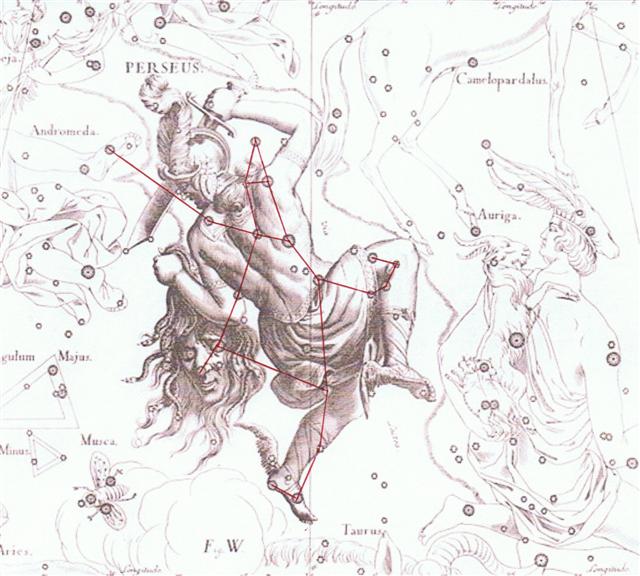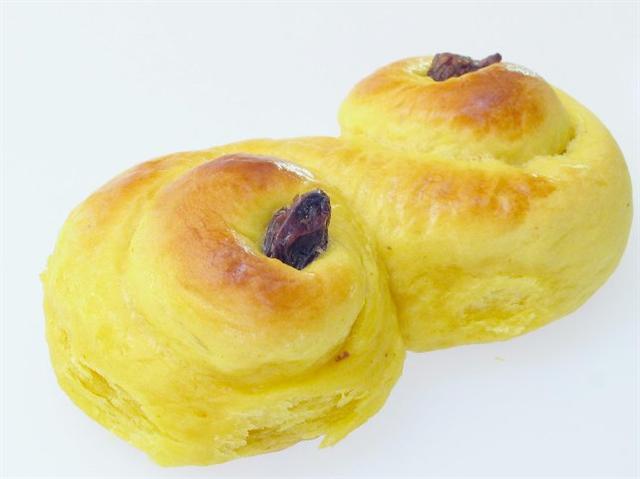I guess the form of the Delphinus constellation - as depicted by those who knew - demanded the outline of the figure to be similar to that for number 8: 
50 is a number which could have been correlated with the
movements of Sun. From the side of Perseus the star Algenib
brought spring light when time was ripe: ... From the 'side' (al-genib) of Perseus there are 5 days to the Pleiades, which possibly is indicated in Metoro's suggestion to count (hia) to the net (kupega) - if I am reading him correctly:
The last star (γ) of the Dolphin rose 265 (= 365 - 100) days later:
The triplet of mata in Ca11-31 are at left, in the past, and the first star of Aquarius (Albali, ε) confirms the idea - of how the front (facial, mata) side of the year has been 'swallowed' (Hakagaro): ... ε [Aquarii] was Al Bali, the brightest one of the 21st manzil, Al Sa'd al Bula', the Good Fortune of the Swallower, which included μ and ν; these last also known as Al Buläān in the dual. Kazwini said that this strange title came from the fact that the two outside stars were more open than α and β of Capricorn, so that they seemed to swallow, or absorb, the light of the other!
In the dark times before the December solstice we in Sweden have the custom of eating buns named 'Lussekatter' (Lucia cats):
This type of bun is also formed like the figure 8, which makes me think of the equation 400 / 8 = 50 and number 8 as a Sign for the closed double cycle of the year ('year in leaf' + 'year in straw'). 8 = 4 + 4 as if each such 4-cornered cycle could represent a 'square earth'. The little piece of 'dirt' ('earth') becomes an upraised dry raisin in the Swedish yellow buns. We have recently aquired a key piece of information to our vast puzzle: ... kelson, keelson ... line of timber inside a ship parallel to the keel. XVII. ME. kelswayn, kelsweyn, kelsyng, mod. kelsine, perh. points to an original *kelswin, the nearest parallel to which, and the prob. source, is LG. kielswin (whence also G. kielschwein, Da. křlsvin, Sw. kölsvin), f. kiel KEEL + (prob.) swin SWINE, used like cat, dog, horse, for a timber ... The timbers of a ship had names referring to 4-legged mammals walking on land (cat, pig, etc). A ship was like a piece of dry land upraised from the sea: "4 March 1779. The British ships are again at Kaua'i, their last days in the islands, some thirteen months since their initial visit. A number of Hawaiian men come on board and under the direction of their women, who remain alongside in the canoes, the men deposit navel cords of newborn children in cracks of the ships' decks (Beaglehole 1967:1225). For an analogous behavior observed by the missionary Fison on the Polynesian island of Rotuma, see Frazer (1911, 1:184). Hawaiians are connected to ancestors (auumakua), as well as to living kinsmen and descendants, by several cords emanating from various parts of the body but alike called piko, 'umbilical cord'. In this connection, Mrs. Pukui discusses the incident at Kaua'i: I have seen many old people with small containers for the umbilical cords... One grandmother took the cords of her four grandchildren and dropped them into Alenuihaha channel. 'I want my granddaughters to travel across the sea!' she told me. Mrs. Pukui believes that the story of women hiding their babies' pikos in Captain Cook's ship is probably true. Cook was first thought to be the god Lono, and his ship his 'floating island'. What woman wouldn't want her baby's piko there?" (Pukui et al. 1972, 1:184)" (Marshall Sahlins, Islands of History) I believe this idea is necessary for understanding the otherwise puzzling 'sticks' Raven got from his earlier self as grandfather: ... The Raven stole the skin and form of the newborn child. Then he began to cry for solid food, but he was offered only mother's milk. That night, he passed through the town stealing an eye from each inhabitant. Back in his foster parents' house, he roasted the eyes in the coals and ate them, laughing. Then he returned to his cradle, full and warm. He had not seen the old woman watching him from the corner - the one who never slept and who never moved because she was stone from the waist down. Next morning, amid the wailing that engulfed the town, she told what she had seen. The one-eyed people of the sky dressed in their dancing clothes, paddled the child out to mid-heaven in their canoe and pitched him over the side ... ... The old man gave the Raven two small sticks, like gambling sticks, one black, one multicoloured. He gave him instructions to bite them apart in a certain way and told him to spit the pieces at one another on the surface of the sea. The Raven climbed back up the pole, where he promptly did things backwards, just to see if something interesting would occur, and the pieces bounced apart. It may well be some bits were lost. But when he gathered what he could and tried again - and this time followed the instructions he had been given - the pieces stuck and rumpled and grew to become the mainland and Haida Gwaii. |


